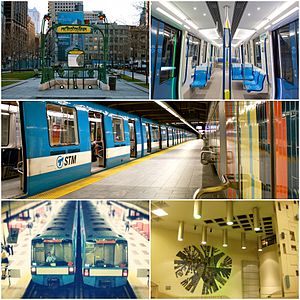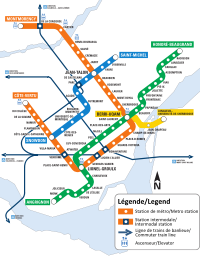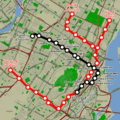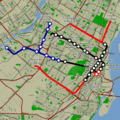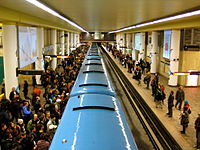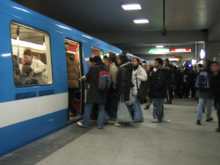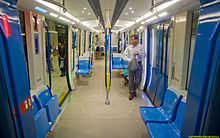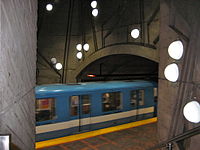
Montreal Metro
Background to the schools Wikipedia
SOS Children have produced a selection of wikipedia articles for schools since 2005. Click here to find out about child sponsorship.
| Montreal Metro | |||
|---|---|---|---|
|
|
|||
| Background | |||
| Locale | Montreal, Quebec, Canada | ||
| Transit type | Rapid transit | ||
| Number of lines | 4 | ||
| Number of stations | 68 | ||
| Daily ridership | 1,111,700 (per weekday 2011) | ||
| Operation | |||
| Began operation | October 14, 1966 | ||
| Operator(s) | Société de transport de Montréal | ||
| Number of vehicles | 759 | ||
| Technical | |||
| System length | 69.2 km (43.00 mi) | ||
| Track gauge | 1,435 mm (4 ft 8 1⁄2 in) standard gauge with running pads for the rubber tired wheels outside of the steel rails |
||
| Electrification | " Third rail", 750 V DC on the guide bars at either side of the track | ||
| Average speed | 40 km/h (25 mph) | ||
| Top speed | 72 km/h (45 mph) | ||
|
|||
The Montreal Metro (French: Métro de Montréal) is a rubber-tired metro system, and the main form of public transportation underground in the city of Montreal, Quebec, Canada.
The Metro, operated by the Société de transport de Montréal (STM), was inaugurated on October 14, 1966, during the tenure of Mayor Jean Drapeau. Originally consisting of 26 stations on three separate lines, the Metro now has 68 stations on four lines measuring 69.2 km (43.00 mi) in length, serving the north, east, and centre of the Island of Montreal with connections to Longueuil, via the Yellow Line, and Laval, via the Orange line.
The Metro system is Canada's busiest subway system in total daily passenger usage, serving an average of 1,111,700 daily passengers per weekday (as of Q1 2011). In 2011, 308.7 million riders (transfers not included) used the Metro. According to the STM website the Metro system has transported over 7 billion passengers as of 2010, roughly equivalent to the world's population. Montreal has built one of North America's largest urban rapid transit schemes, serving the third-largest number of passengers overall behind New York and Mexico City, and attracting the second-highest ridership per capita behind New York.
The Montreal Metro was inspired by the Paris Metro and in turn is also the inspiration for the Lyon Metro, Marseille Metro, and the Mexico City Metro, all constructed a few years later, and all of which also share the same rubber-wheel car design and similar Montreal Metro station architecture.
History
Urban transit first came in 1861 where a first line of horse-drawn cars started to operate on St. James St. (now St-Jacques). Eventually, as Montreal grew, a comprehensive network of streetcar lines provided service almost everywhere. But urban congestion started to take its toll on streetcar punctuality, so the idea of a subway was soon considered.
Abandoned projects
Starting in 1910, where a first proposal was tabled, the Montréal subway would prove to be an elusive goal of the Montréal Tramways Company, and following municipalization, of the Montreal Transportation Commission.
The first subway proposal, dated 1910, was for a single line running underneath Bleury Street and Park Avenue from Craig Street (now St-Antoine Street) all the way to Mont Royal Avenue. The line was to run underground from Craig to Pine Avenue. An eventual expansion up Saint Laurent Boulevard to De Montigny was also contemplated at the time.
In 1944, the Montreal Tramways Company proposed a 2-line network, running underneath Rue Sainte-Catherine from Square Cabot ( Rue Atwater) to Avenue Papineau, and a second line under St-Denis Street (from Jean-Talon to Notre-Dame), then turning westwards under Notre-Dame and St-Jacques Street all the way to Rue Guy, then turning north and connecting with the other line at Guy.
Proposed extensions were to run northward under De Lorimier up to Beaubien, eastward from De Lorimier to Viau under Rue Ontario, northward Chemin Côte-des-Neiges and Queen-Mary to Snowdon (Décarie), westward under Sherbrooke to Girouard, and southwards under Wellington, Centre and Verdun to 1ère Avenue in Verdun.
In 1953 the newly formed Montreal Transportation Commission proposed a single line, running under Rue Sainte Catherine from Rue Atwater towards Peel where the line would have turned south, going underneath Square Dorchester all the way down to Rue Saint-Jacques, which it followed to Rue Saint-Denis. Then, it would have gone north all the way to Boulevard Crémazie, right by the D'Youville maintenance shops.
Proposed extensions were to run northwest under Sherbrooke, Girouard & Décarie to De L’Église, in St-Laurent, northeast under D’Iberville and Jean-Talon to Pie-IX and eastward under Ontario to Viau. By this point, construction was well underway on Canada's first subway line in Toronto under Yonge Street, which would be opened in 1954.
In 1963 the last proposal was the closest to what was to be built. The major difference with the built initial network was that there was no line to Longueuil, line 2 extended northward only to Crémazie instead of Henri-Bourassa, and that the Canadian National commuter train lines to Cartierville and Montréal-Nord would be integrated into the system. Negotiations with CN did not work out, and line 3 was left unbuilt. However, a line numbered 4 was built to Longueuil, on the south shore, to serve Île Sainte-Hélène, site of Expo ’67.
Proposed extensions were to run northwest under Sherbrooke, Girouard & Décarie to De L’Église, in St-Laurent, northeast under d’Iberville to Crémazie and eastward under Ontario to Viau.
The 1960s were very optimistic years. Metro planning did not avoid the general exuberance of those years, and a 1967 study proposed six additional lines that would bring the 25 km of Métro lines of 1967 to 112 km for 1982.
Unbuilt lines/extensions
The Orange and Blue lines, however, were not planned to end where they eventually did in 1990. The Orange Line was meant to have two or three more stations beyond Côte-Vertu; however, priority funding was given to complete the Blue Line. The plans for Grenet/Poirier, Bois-Franc, and Salaberry stations were abandoned. The Blue Line was also shortened to reduce costs. It had been projected to have stops west of Snowdon (Côte Saint-Luc, Cavendish, Montréal-Ouest, Lafleur) and east of Saint-Michel ( Pie-IX, Viau, Lacordaire, Langelier, Galeries d'Anjou).
Two Métro lines in initial planning were also abandoned: the Line 7/Pie IX - Saint-Leonard/White Line, also due to the same funding issues. Proposed for by the Bureau des Transports de Montréal (BTM) in September 1983, the original project for a new north-south line (Line 7, the number 6 being reserved for another surface metro line proposed by the Ministère des Transports du Québec (MTQ)) would have had 10 stations (from Pie-IX to Léger), which then was proposed by the Communauté urbaine de Montréal (CUM) at the start of 1984, this time having 12 stations (from Pie-IX to Maurice-Duplessis/Langelier)
- Line 3
- Line 6 ( Du Collège to Point-aux-Trembles)
- Line 7 ( Pie-IX to Maurice-Duplessis/Langelier)
Current network
Construction began in May 1962 and was undertaken before Montreal was chosen as host of the 1967 World's Fair ( Expo 67), held in the summer of 1967. Regardless of the fair, the city badly needed a mass transportation system, as demonstrated by numerous proposals dating back to 1910. The main lines ( Green (Line 1), Atwater to Frontenac; and Orange (Line 2), Bonaventure to Henri-Bourassa) were opened gradually starting in October 1966, with the Yellow line (Line 4) ( Berri-de-Montigny to Longueuil, on the south shore of the Saint Lawrence River) not opened until April 1967.
A Line 3 had been intended as a surface metro running in part through the existing railway tracks running under Mount Royal to Cartierville. But then, as negotiations with the Canadian National Railway (CN Rail) for the use of their tracks and tunnel were stalled, Montreal was chosen as host of the Expo 67. Plans and budgets were therefore redirected for the design and construction of a replacement line, Line 4, constructed especially for Expo 67, in place of the never built Line 3. (The CN tracks under Mont-Royal are still used for the Deux-Montagnes commuter train, which was modernized in 1995.) The Montreal Métro nonetheless continues to be numbered as if this proposed line had been constructed as Line 3 of the Métro.
With the awarding of the 1976 Summer Olympics to Montreal, construction began in October 1971 for the extension of Line 1 from Frontenac to Honouré-Beaugrand to service the main Olympic site; the new stations were opened in June 1976.
Later, Line 1 was extended from Atwater to Angrignon (September 1978), while Line 2 was extended from Bonaventure to Place-Saint-Henri (April 1980), Snowdon (September 1981), Côte-Sainte-Catherine and Plamondon (January and June 1982), and Du Collège (January 1984).
Two years later, a new line ( Blue (Line 5)) was built from De Castelnau to Saint-Michel (June 1986), with transfers to Line 2 at Jean-Talon, and Line 2 was extended further to Côte-Vertu (November 1986). Line 5 was then extended to Parc (June 1987), Acadie (March 1988), and the existing Snowdon station on Line 2 (January 1988). The Montreal Metro is Canada's largest subway system.
While a number of proposals for further expansion had been studied over the years, it all came to a stop around 1990, when the Quebec Liberal Party government of Robert Bourassa government placed a moratorium on further metro construction. Then, in 2002, under the Parti Québécois government of Bernard Landry, construction began on a three-station extension of Line 2 from Henri-Bourassa under the Rivière des Prairies to Montmorency on Île Jésus (northwest of the Île de Montréal). This extension was completed and the three new stations were opened on April 28, 2007. Ridership increased by 60,000 a day with the new stations, as of 2009.
Vision 2020
In December 2011, Agence Métropolitaine de Transport announced a "Vision 2020" plan to expand electrification and to build extensions to the blue, orange, and yellow lines.
Network
The four Montréal Métro lines are identified by colour, by number, or by terminus station. The terminus station in the direction of travel is used to differentiate between directions of travel. The busiest line is the Orange Line, while the quietest is the Blue Line. The Yellow Line is the shortest line, with three stations, built for Expo 67. On April 28, 2007, three new stations were opened in Laval along the Orange Line. Metro lines that leave the Île de Montréal are the Orange Line, which continues to Laval, and the Yellow Line, which continues to Longueuil. On weekdays and Saturday and Sundays, the Metro service runs from approximately 5:30 a.m. to 1:00 a.m. on the Green, Orange and Yellow lines and 5:30 a.m. to 12:15 a.m. on the Blue line.
| Line # | Colour | Termini | Year First Built | Year Last Changed | Length | Stations | Rush Hour Frequency | Off-Peak Frequency |
|---|---|---|---|---|---|---|---|---|
| 1 | Green | Angrignon ↔ Honouré-Beaugrand | 1966 | 1978 | 22.1 km | 27 | 2–4 minutes | 4–10 minutes |
| 2 | Orange | Côte-Vertu ↔ Montmorency | 1966 | 2007 | 30.0 km | 31 | 2–4 minutes | 4–10 minutes |
| 4 | Yellow | Berri-UQAM ↔ Longueuil–Université-de-Sherbrooke | 1967 | 1967 | 4.25 km | 3 | 4–6 minutes | 10 minutes |
| 5 | Blue | Snowdon ↔ Saint-Michel | 1986 | 1988 | 9.7 km | 12 | 3–5 minutes | 6–10 minutes |
Operation
Metro service starts at 05:30 and stops at 01:00 on weekdays and Sunday, and 01:30 on Saturday. However, the Blue Line stops service earlier, at 00:15 due to lower passenger volumes. During rush hour, there are two to five minutes between trains on the Orange and Green Lines. The frequency, however, decreases to 12 minutes during late nights.
The STM operates both the Metro and the bus services in Montreal, and thus transfers between bus and Metro are free. Fare payment is via a barrier system, including magnetic tickets and passes, as well as a RFID card.
Fares are partially integrated with the Agence métropolitaine de transport's commuter rail system, which links the Metro to the outer suburbs via five interchange stations.
OPUS
On April 21, 2008, the STM unveiled the contactless smart card called OPUS (a play on the French phrase aux puces, referring to the word for the chip used in the cards) as a means of fare payment. In preparation for this new step in Montreal's public transportation network, turnstiles which incorporate the reader and automated vending machines had already been installed in metro stations; buses had previously been fitted with new fare boxes that incorporate the card reader, in order to ensure the uniformity of methods of payment across Montreal's transit network and that of its suburbs.
The smart card provides seamless integration with other transit networks of neighbouring cities, eliminating the need to carry small change or purchase different tickets. The commuter train service, run by the Agence métropolitaine de transport, requires the purchasing of a ticket different from those offered by the STM. Unlike the magnetic stripe cards previously in use, which had been sold alongside the new OPUS cards up until May 2009, the contactless smart card is not at risk of becoming demagnetized and rendered useless, and does not require patrons to slide the card through a reader.
Costs to the STM related to the project are approximately $138 million, compared to the original estimated cost of some $100 million. The project was originally supposed to be implemented in 2006.
Design
The design of the Metro was heavily influenced by Montreal's winter conditions. Unlike other cities' metros, nearly all station entrances in Montreal are completely enclosed; usually they are in small, separate buildings with swivelling doors meant to mitigate the wind caused by train movements that can make doors difficult to open.
All separate entrances are set back from the sidewalk; as well, several stations in Downtown Montreal are directly connected to buildings, and thus have several entrances inside existing buildings and street-level entrances, making the Metro an integral part of Montreal's underground city despite its lack of elevators. Several metro entrances are also located within building facades. Only three stations have open entrances, which are prevalent in other cities. During the past six years several stations have been upgraded with lifts to accommodate passengers with disabilities; such stations include Henri-Bourassa through Montmorency, Berri-UQAM, Lionel-Groux, and Côte-Vertu.
Montreal's metro is renowned for its architecture and public art. Under the direction of Drapeau, a competition among Canadian architects was held to decide the design of each station, ensuring that every station was built in a different style by a different architect. Several stations, such as Berri-UQAM, are important examples of modernist architecture, and various system-wide design choices were informed by the International Style.
Along with the Stockholm Metro, Montreal pioneered the installation of public art in the metro among capitalist countries, a practise that beforehand was mostly found in socialist and communist nations (the Moscow Metro being a case in point). More than fifty stations are decorated with over one hundred works of public art, such as sculpture, stained glass, and murals by noted Quebec artists, including members of the famous art movement, the Automatistes.
Some of the most important works in the Metro include the stained-glass window at Champ-de-Mars station, the masterpiece of major Quebec artist Marcelle Ferron; and the Guimard entrance at Square Victoria station, like the famous metro entrances designed for the Paris Métro, on permanent loan since 1966 by the RATP to commemorate its cooperation in constructing the metro. Installed in 1967 (the 100th anniversary of Guimard's birth), this is the only authentic Guimard entrance in use outside Paris, although reproductions using original moulds were given to Mexico City ( Metro Bellas Artes on line 8), Chicago ( Van Buren Station on the Metra network), Lisbon ( Picoas station on the yellow line) and Moscow ( Kievskaya station on the Arbatsko-Pokrovskaya).
Rolling stock
The Montreal Metro's 759-car fleet runs entirely underground and uses exclusively rubber tires instead of steel wheels. As noted in the STM official document, The Montreal Métro, a source of pride, the Metro runs entirely underground because the cars are not weatherproof and the electrical system would be severely affected by rain and melting snow.
Conception of the first generation of rolling stock in Montreal went beyond just adopting the MP 59 metro car from Paris.
North American cities building modern subway systems ( Washington, D.C., San Francisco, Atlanta, Montreal) in the 1960s and 1970s were in search of modern rolling stock that not only best fit their needs, but also encompassing a change in industrial design that focused on the aesthetics and performance of public transit vehicles.
Train floor levels are near flush with the station platforms, but unlike the Washington, D.C. Metro, Montreal's Metro system is not always wheelchair accessible. Most wheelchair users cannot board independently because of a gap between the car and the platform. Only seven stations are wheelchair accessible, and only on the Orange Line. This has become a sore point for accessibility advocates in Montreal. The three stations in Laval are provided with elevators, and four stations - Lionel-Groulx, Berri-UQAM, Henri-Bourassa, Bonaventure and Cote-Vertu had elevators added in 2009 and 2010, although Bonaventure station is only partially accessible pending the construction of elevators linking the mezzanine to street level. Four stations will be equipped with elevators by 2016, meaning that the service would be fully accessible in 2085. The remodelling of the seating arrangement in the MR-73 cars has added a space for wheelchairs.
Like the metro cars of most other systems in the 1960s and 1970s, Montreal's cars do not have air conditioning. This is mainly because the metro is built entirely underground and air conditioning would heat the tunnels creating a much bigger problem. The Montreal trains are among the oldest North American metro trains in service - the MR-63 dates back to the system's opening in 1966 and the MR-73 to 1976 - but extended longevity is expected of rolling stock operated under fully sheltered conditions. The lack of air conditioning can make trips uncomfortable for passengers. Passengers cannot move between cars once on board with the current train stock, which can be an inconvenience if the car becomes overcrowded or when looking for a seat. The trains are 2.5 m (8.20 ft) wide, narrower than the width of the trains used by most other North American metro systems. This narrow width limits the capacity of the trains, but allowed the use of single tunnels (for both tracks) in construction of the Metro's subway lines. In response to overcrowding on the orange line, a redesign of the MR-73 cars removed some seats to make for more standing room. The new trains MPM-10 (Azur) will allow passengers to move between cars once on board.
Design
Montreal's metro trains are made of LAHT (low-alloy high-tensile) steel, painted blue with a thick white stripe running lengthwise. Trains are assembled in three, six or nine-car lengths. Each three-car segment element consists of two motor cab cars encompassing a trailer car. Each car is 2.5 m (8 ft 2.4 in) wide and has four wide bi-parting leaf doors on each side for rapid passenger entry and egress. The small cross section of the cars allows easier tunnel construction under existing underground utilities. The total capacity of each car is 160 passengers, 39 to 40 of which are seated. Design specifications called for station dwell times of typically 8 to 15 seconds.
Each car has two sets of bogies (trucks), each with four sets of support tires, guide tires and backup conventional steel wheels. The motor cars each have four direct-current traction motors coupled to reduction gears and differentials. Montreal's metro trains use electromagnetic brakes, which create retarding forces against the side rails of the track. The electromagnetic brakes are generated by the train's kinetic energy until it has slowed down to about 10 km/h (6.2 mph). The train then uses composite brake blocks made of yellow birch injected with peanut oil to bring it to a complete stop. Two sets are applied against the treads of the steel wheels for friction braking. Hard braking produces a characteristic burnt popcorn scent. Wooden brake shoes perform well, but if subjected to numerous high-speed applications they develop a carbon film that diminishes brake performance.
Rubber tires make the Montreal Metro exceptionally quiet, transmit minimal vibration, and help the cars climb uphill more easily and negotiate turns at high speeds. However, the advantages of rubber tires are offset by noise levels generated by traction motors, which are noisier than the typical North American subway car. Trains can climb slopes of up to 6.5% and economize the most energy when following a humped-station profile (track profiles that descend to accelerate after leaving a station and climb before entering the station). Steel-wheel train technology has undergone significant advances and can better round tight curves, and climb and descend similar grades and slopes but despite these advances, steel-wheel trains still cannot operate at high speeds (45 mph/72 km/h) on the same steep or tightly curved track profiles as a train equipped with rubber tires.
Train operation
All lines but the Yellow Line are equipped with automatic train control. Generally, the train operator does the closing of doors, and starts the DA (Départ automatique, automatic departure) Then the train drives itself. The train operator can also drive the train manually at his or her discretion. Signalling is effected through coded pulses sent through the rails. Coded speed orders and station stop positions transmitted through track beacons are captured by beacon readers mounted under the driver cabs. The information sent to the train's electronic modules conveys speed information, and it is up to the train automatic control system computer to conform to the imposed speed. Additionally, the train computer can receive energy-saving instructions from track beacons, providing the train with four different economical coasting modes, plus one mode for maximum performance. In case of manual control, track speed is displayed on the cab speedometer indicating the maximum permissible speed. The wayside signals consist of point (switch/turnout) position indicators in proximity to switches and inter-station signalling placed at each station stop. Trains often reach their maximum speed of 70–72 km/h (43.5–44.7 mph) in 16 to 26 seconds depending on grade and load.
Trains are programmed to stop at certain station positions with a precise odometer (accurate to plus or minus five centimetres). They receive their braking program and station stop positions orders (one-third, two-thirds, or end of station) from track beacons prior to entering the station, with additional beacons in the station for ensuring stop precision. The last beacon is positioned at precisely 12 turns of wheels from the end of the platform, which help improve the overall precision of the system.
Trains draw current from two sets of 750-volt direct current guide bar/ third rails on either side of each motor car. Nine-car trains draw large currents of up to 6,000 amperes, requiring that both models of rolling-stock have calibrated traction motor control systems to prevent power surges, arcing and breaker tripping. Both models have electrical braking (using motors) to assist primary friction braking, reducing the need to replace the brake pads.
Two models of train are used on the Metro. The Canadian Vickers-built MR-63, delivered for the metro's opening in 1966, is used on the Green and Yellow Lines and the Bombardier-built MR-73 is used on the Orange and Blue lines
Canadian Vickers MR-63
Motor cars weigh about 27 tonnes (26.6 long tons; 29.8 short tons), while trailer cars weigh 20 tonnes (19.7 long tons; 22.0 short tons). A three-car set (one element) weighs a total of 74 tonnes (72.8 long tons; 81.6 short tons).
The MR-63 is identified with grey interiors, four ventilation hoods protruding over the roof of each car, two 113 kW (152 hp) 360-V series traction motors that make a whining noise, and round cab headlights. Montreal's rolling stock is among the oldest still in use on any metro system in the world.
Maintenance of Montreal's subway cars is rigorous, as reliability levels (Mean Distance Between Failures/MDBF ratings) are more than double that of typical North American subway cars.
The MR-63 is the first generation of high-performance subway cars, a mixture of technology dating back to the mid-1960s and modern train technology. The MR-63 model has undergone numerous technological and reliability upgrades. Major upgrades include on-board computer modules for automatic train control in 1976 with subsequent revisions of hardware and software, solid-state door interlocks in 2003, modern ergonomic driver cabs with new digital dashboards, and automatic station annunciators in 2005. Most notably, all the MR-63 carshells emerged factory-fresh with new interiors and a new paint scheme after being fully refurbished at the GEC Alstom Pointe St. Charles workshops in 1993. As a result, the MR-63 fleet appears relatively new, gleaming and modern despite their age.
The MR-63 fleet remains exceptionally reliable ( Mean Distance Between Failures of 200,000 km/124,300 mi in 2004) by North American standards. However, they suffer elevated levels of vandalism, they retain many obsolete components, parts availability is diminishing, and ride quality has deteriorated over the years as their suspension systems and rubber spring packs harden with old age. Poor ride quality has not been attributed to the tires or tracks.
The MR-63 model uses a series-to-parallel servo camshaft rheostat to control and regulate power to its traction motors; this control system can be heard tapping under the floor of a motor car as the train undergoes rapid acceleration at an initial rate of 1.33 m/s2 (4.4 ft/s2) (4.8 km/(h·s) or 3.0 mph/s). This control system also features a dynamic rheostatic braking mode that uses the motors to slow the train, turning the motors into generators and dissipating the resulting energy as heat in the rheostat grid.
The MR-63 fleet will remain in service up until 2017, with their projected replacement by 2014. An exclusive interview in the January 20, 2010 edition of the 24H announced that approximately $5 million will be invested in refurbishing the interior of the MR-63 until the replacements will be put in service.
Bombardier Transportation MR-73
The MR-73, delivered in 1976, is the second generation of high-performance metro cars, identified by rectangular cab headlights, blue and dark orange interiors, 124 kW (166 hp) traction motors that growl while accelerating out of a station, side vents, and a unique three-note sound signature when the train pulls out of a station. The initial rate of acceleration of the MR-73 model is 1.43 m/s2 (4.7 ft/s2) (5.2 km/(h·s) or 3.2 mph/s). The three-note sound is produced by traction motor control equipment called a "current chopper", which is used to control and power the motors on the train in stages without incurring a power surge. It does this by modulating the current in 5 consecutive stages (90, 120, 180, 240 and 360 Hz), the latter 3 being normally audible. A prototype for the current chopper has been built by the Canron company using a Jeumont original design in the early 1970s on an MR-63 train. Two of the three elements of this "Jeumont Train" are operated on the Line 1 Green among rheostatic-started MR-63s. One is much louder than the other. They are the only two to exhibit the whole five-note audible signature in normal operation, even though it is possible to hear them during longer than usual starts on regular MR-73s. As of 2012, the MR-73s play the three-note sequence whenever the doors are about to close.
These notes are the same as the first three notes of Aaron Copland's " Fanfare for the Common Man", one of the musical themes for Expo '67, though this is apparently just a coincidence. Some MR-73s originally sported murals of Montreal at the end of the cars, however these were damaged by vandalism and removed long ago.
The MR-73 has a different electrical braking system than the MR-63 to assist friction braking. The MR-73's current chopper recuperates energy when in braking mode, turning traction motors into generators and sending a regulated current back into the traction power supply for other trains to use. Electrical braking is most effective when one train draws power while starting while another train at a different location sends power while braking.
The Mean Distance Between Failures (MDBF) for the MR-73 exceeds 200,000 mi (322,000 km) in 2004. Beginning December 2005, the MR-73 fleet underwent $40 million in renovations to reconfigure interior seating to increase total car capacity, and install new poles and new panels with a new ergonomic colour scheme that discourages vandalism, decreases motion sickness and promotes aesthetic harmony. The renovations also include an ergonomic full-spectrum lighting system that provides therapeutic anti-depression effects for its passengers. Like the older MR-63 metro fleet, the MR-73 driver cabs will be modernized and equipped with ergonomic features and digital dashboards.
Bombardier-Alstom MPM-10 (2014)
In May 2006, the Quebec Government announced the negotiation of a $1.2 billion contract to replace the MR-63 metro fleet of 336 cars. Alstom voiced its dismay over directly awarding the contract (to Bombardier) without a bidding process. Negotiations between the STM and Bombardier were to be ongoing until 2007. The negotiations focused on the project's cost controls, terms of contract, train specifications and warranty. If negotiations had failed, the Quebec government and the STM would have reverted to a bidding process.
On January 10, 2008, Quebec Superior Court Judge Joel Silcoff rendered his decision regarding Alstom's filing of legal action against the Quebec government's ministry of transportation. The latter sought to by-pass the bidding process, citing that Bombardier was the only domestic candidate capable of fulfilling the eventual contract. Silcoff ruled in favour of Alstom, enabling the company to bid on the contract.
As of February 6, 2008, the Government of Quebec decided to begin the bidding process, which would serve to save time, delaying delivery of the first trains by 9 to 12 months.
On October 5, 2010, the Quebec government gave the contract to Bombardier-Alstom, valued at $3 billion. The new cars are expected to start rolling by February 2014.
The 468 new cars, arranged in 52 nine-car sets, will feature full-width walkways between the cars which can be occupied by passengers, resulting in higher train capacities. They will also be equipped with an air-suspension system, larger windows and doors, and wheelchair spaces, although the vast majority of Metro stations are not wheelchair-accessible. They will also feature more natural lighting, high definition televisions, a new PA system and surveillance cameras. News reports also suggest that the new rubber-tire trains will have to meet very demanding performance requirements: higher speeds (up to 80 km/h), powerful acceleration, high-speed gradeability, high-performance brakes, good ride comfort, low noise, low maintenance costs, low energy costs and high levels of reliability. Improving on the performance levels of the current fleet and developing new rolling-stock capable of using sheer speed as a means of increasing line capacity will represent a major challenge to Bombardier and Alstom.
Maintenance
Rolling stock maintenance is effected in three facilities, in two locations.
Plateau d'Youville
The Plateau d'Youville, located in the north end of the city is located at the intersection of Crémazie and Saint-Laurent Boulevards.
It provides heavy maintenance of buses, subway cars, light maintenance of MR-73 subway cars and is the main base for the track maintenance workshops (where track sections are pre-assembled prior to installation).
Beaugrand Garage
The Beaugrand Garage is located east of line 1 terminus Honouré-Beaugrand. It is entirely underground.
It provides light maintenance on MR-63 subway cars.
Centre d'attachement Duvernay
Duvernay is a garage and base for maintenance of way equipment. It accesses the network through the line 1/line 2 interchange southeast of Lionel-Groulx. The access building is located at the corner of Duvernay and Vinet streets in Sainte-Cunégonde.
Centre d'attachement Viau
Viau is a garage and base for maintenance of way equipment. It accesses the network immediately west of the Viau station (line 1). The access building is within the Viau station building; in fact, facilities are visible from trains going west of the station.
Snowdon
The interchange track between lines 2 and 5 south/west of Snowdon station is used for the storage of maintenance of way equipment. There are no surface facilities.
The tail tracks west of Snowdon station extend about 790 metres west of the station, reaching the border of the city of Hampstead. The end of the track is marked by an emergency exit on the corner of Queen Mary and Dufferin Roads.
Garages
Idle trains are stored in four garages: Angrignon (west of Angrignon line 1 terminus), Beaugrand (east of Honouré-Beaugrand line 1 terminus), Saint-Charles (north of Henri-Bourassa terminus) and Montmorency. The latter has been built perpendicular to its station to allow an easier potential expansion of the Line 2 deeper in Laval territory.
Future projects
City of Montreal
On June 12, 2008 the City of Montreal released its overall transportation plan for the immediate future. In addition to service improvements in bus and rail, the following projects were given priority status in the overall transportation scheme:
- The blue line will be extended in two phases: from Saint-Michel up to Pie-IX Boulevard. The second phase will extend past Pie-IX to the boroughs of Saint-Leonard and Anjou, committing to the line's original design.
- The orange line will also be extended northwest from the Côte-Vertu station, up to the Bois-Franc commuter rail station in Saint-Laurent. The extension will probably include two stations: Poirier and Bois-Franc (an intermodal station with the Bois-Franc Station of the Deux-Montagnes commuter line). See also City of Laval below.
- A new extension of Line 4 from Berri-UQAM is being studied in the long term that would go to McGill station to ease congestion on that part of the green line.
- A 2006 study rejected the possibility and cost of an extension from Lionel-Groulx to the City of Brossard on the south shore of Montreal as an alternative to the proposed light rail project in the Champlain bridge corridor.
City of Longueuil
- In 2001, The Réseau de transport de Longueuil (RTL) has considered an extension of Line 4 with four new stations beyond Longueuil–Université-de-Sherbrooke, under the city of Longueuil to Collège Édouard-Montpetit but their priority was switched to the construction of the proposed light rail project in the Champlain bridge corridor. In 2008, Longueuil Mayor Claude Gladu brought the proposal back to life stating that an expansion to College Édouard-Montpetit was a priority for his city.
- The first new station (Vieux-Longueuil) is slated to be located at the corner of Rue Saint-Charles and Rue Saint-Jean in the Old Longueuil neighbourhood. This area is generally considered to be the downtown area of Longueuil.
- The second station (Gentilly) would be located at the corner of Chemin Chambly and Rue Gentilly. The station would be located near the campus of Collège Édouard-Montpetit.
- The third station (Curé-Poirier/Roland-Therrien) is to be located at the corner of Boulevard Curé-Poirier and Boulevard Roland-Therrien, a major intersection of two commercial arteries.
- The fourth station (Jacques-Cartier/De Mortagne) would be located at the intersection of Boulevard Jacques-Cartier and Boulevard Roland-Therrien. This station would serve as a regional hub with buses available to the cities of Boucherville, Varennes and Sainte-Julie. It would also be in proximity to Centre hospitalier Pierre-Boucher, Longueuil's second largest hospital.
City of Laval
- On July 22, 2007, the mayor of Laval, Gilles Vaillancourt, with the ridership success of the current Laval extension, announced his wish to loop the Orange line from Montmorency to Côte-Vertu stations with the addition of six (or possibly seven) new stations (three in Laval and another three in Montreal). He proposed that Transports Quebec, the provincial transport department, set aside $100 million annually to fund the project, which is expected to cost upwards of $1.5 billion. See also City of Montreal (The orange line) above.
- On May 26, 2011, the mayor of Laval, Gilles Vaillancourt, after the successful opening of highway 25 toll bridge in the eastern part of Laval, proposed that Laval, in the next decades, will develop the remaining territories with a transit oriented development (TOD) approach called "Évolucité". At the heart of the project is a plan of building five new metro stations: four on the west branch of line 2 and one more of the east branch of line 2. The next to last station on the west branch will act as a corresponding station between the east branch and the west branch of the Orange Line; the finished line should look like this:
Future Line 2 orange of the (West Branch to East Branch)
- 1- Carrefour (*) (Daniel-Johnson / Le Carrefour)
- 2- St-Martin (*) (C) (St-Martin Ouest / Chomedey)
- 3- Notre-Dame (*) (Notre-Dame / Curé-Labelle)
- 4- Lévesque (*) (Lévesque / Curé-Labelle)
- 5- Gouin (*) ( Gouin / Grenet)
- 6- Bois-Franc (*) (T, Bois-Franc station) ( Boulevard Henri-Bourassa / Marcel-Laurin)
- 7- Poirier (*) (Poirier / Grenet)
- 8- Côte-Vertu & Terminus Côte-Vertu
- 9- Du Collège
- 10- De La Savane
- 11- Namur
- 12- Plamondon
- 13- Côte-Sainte-Catherine
- 14- Snowdon (C)
- 15- Villa-Maria
- 16- Vendôme (T, Vendôme station)
- 17- Place-Saint-Henri
- 18- Lionel-Groulx (C)
- 19- Georges-Vanier
- 20- Lucien-L'Allier (T, Lucien-L'Allier station)
- 21- Bonaventure (T, Central Station)
- 22- Square-Victoria
- 23- Place-d'Armes
- 24- Champ-de-Mars
- 25- Berri-UQAM (C)
- 26- Sherbrooke
- 27- Mont-Royal
- 28- Laurier
- 29- Rosemont
- 30- Beaubien
- 31- Jean-Talon (C)
- 32- Jarry
- 33- Crémazie
- 34- Sauvé (T, Sauve station)
- 35- Henri-Bourassa
- 36- Cartier
- 37- De La Concorde (T, De La Concorde station)
- 38- Montmorency
- 39- De l'Agora (*) (Armand-Frappier et Du Souvenir)
- 40- St-Martin (*) (C) (St-Martin Ouest / Chomedey)
- (*) New Metro station
- (C) Transfer Station with other metro line or branch of the same line.
- (T) Transfer Station with train line.
West Island
- Montreal's West Island newspapers have discussed in 2006 and 2007 plans to extend Line 5 from Snowdon into the Notre-Dame-de-Grâce area of Montreal, as depicted in its original design. A further extension to Dorval was discussed to improve the connection between Downtown Montreal and Pierre Elliott Trudeau International Airport..
Pioneer in tunnel advertising
In the early years of the Montreal Metro's life, a unique mode of advertising was used. In some downtown tunnels, cartoons depicting an advertiser's product were inscribed on the walls of the tunnel at the level of the cars' windows. A retail film processing outfit called Direct Film advertised on the north wall in the Westbound track of the Guy (now Guy-Concordia)-to-Atwater Station (Green Line) during 1967-1969. Strobe lights, aimed at the frames of the cartoon and triggered by the passing train, sequentially illuminated the images so that they appeared to the viewer (passenger) on the train as a movie. Today known as "tunnel movies" or "tunnel advertising", they have been installed in many cities' subways around the world in recent years, for example in the Southgate tube station in London, the MBTA Red Line in Boston, MARTA in Atlanta, the DC Metro, San Francisco's Montgomery Bay Area Rapid Transit station, and on the North South MRT Line on the Mass Rapid Transit of Singapore.

